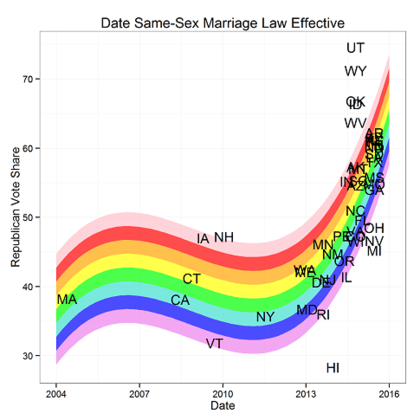As readers know, over the weekend the US Supreme Court declared same-sex marriage the law of the land across all 50 States. Even the States that had expressly changed their State Constitution to limit marriage to one man / one woman, have had their minds changed for them.
This is, of course, huge news in its own right, and will undoubtedly reignite the “culture wars” angle of American politics in the Republican primary. Already, Jeb Bush is running with “That sucks, but let’s move on,” while others are reaching for the pitchforks.
To me, what is most interesting about this change in the US is how quickly the country went from its first law permitting same-sex marriage (2004, in Massachusetts), to a majority of States first acting to ban same-sex marriage, then after 2012 a majority of States moving to allow it (36 by last week), to Federal action to codify the new legal norm. Having all that happen within eleven years is very short, compared to some other episodes of social reform in American history.
Via my earlier post at Polity, the boffins at Bloomberg showed a few weeks ago that the time from the first State permitting something to Federal action was often much longer. For example:
- Almost two hundred years passed between the first State legalising interracial marriage, and Federal action to allow it nationwide.
- Over seventy years went by when the first State banned alcohol to Federal prohibition in 1920.
- It took about thirty years to go from female suffrage in one state to female suffrage everywhere.
The major social change that looks most like same-sex marriage, in terms of timing, is abortion. Colorado legalised abortion in limited circumstances in 1967, and by 1973 it was legal nationwide after Roe v Wade.
One of the things that has made abortion reform so long-term controversial in the US is that the Supreme Court acted early, with only a few States allowing it and without really strong public support.
Is that status as a permanent schism in American politics likely to befall same-sex marriage, given it also had a short timeframe from first State action to Federal action? I don’t think so, for two reasons:
- Public opinion on same-sex marriage has moved quickly, and moved ahead of the Court. Via 538, polling now routinely finds 55-60% of Americans favouring same-sex marriage in the US, up from around 30% just ten years ago.
- A majority of the States had already allowed same-sex marriage before the US Supreme Court acted. This is very different from abortion, where only around a third of States had acted pre-Court.
My prediction on this is that there will be some Republican wailing and gnashing-of-teeth this Republican primary cycle, then the eventual nominee will choose not to make it a big deal in the general election because, you know, 60% like the change – probably more by then. After that, the issue will die away as god-fearing conservatives find that the fabulous weddings don’t actually undo the dour ones.
Let’s say we have an “anec-model” that permissive social change in the US probably requires majority public support and majority State backing before the Supreme Court can make Federal action stick. What, then, would that say about prospects for marijuana reform and for death with dignity laws?
Marijuana: Only four States have completely legalized it at this point, although 23 States have done so for medicinal purposes. Public opinion sits on a 50-50 knife-edge. If the Court found grounds to act on marijuana now, it wouldn’t quite meet our twin tests, and so could dissolve into a bun-fight. Advocates need to both convince more State legislatures or Courts to act, and also increase public support.
Death with dignity: Oregon passed the first US death with dignity Act in 1997. Since then another two states have followed suit, although there are some within-state differences in a couple more States, and others now reviewing their laws, notably California. Public opinion, however, is strong and consistent. Gallup reports that public support for physician-assisted dying has hovered around 70% for the last fifteen years (although this drops to around 55-60% if the question is phrased as “suicide” rather than “end the patient’s life.”) So for death with dignity campaigners, the public opinion battle is already won; they just need more legislatures on side.

